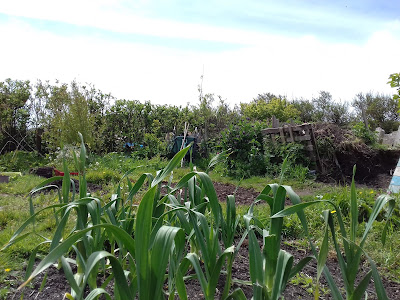 |
| A Year on the Allotment - January - Allotment Plan |
A Year on the Allotment
A series that aims to help new allotment growers to get started and produce lovely crops to eat.
This post is about planning your allotment.
1.3 January - An Allotment Plan.
One thing well worth doing when you get your first plot, then at the start of each new growing year, is a plan for your allotment.
You can do this with an online computer based tool, or the "old-fashioned" way with pen / pencil and paper. Although I have worked as an IT professional for more than 30 years, I still prefer doing this on paper. It works for me - but its up to you.
Here are some good reasons for putting together an allotment plan:
- Gets you thinking about what you want to grow.
- You can work out the best use of space.
- You can make a start on a list of seeds and other supplies needed.
- Its fun! Gets you looking forward to a year ahead on the plot.
My plan includes the layout of the plot, where crops will go and then a list of seeds and other items that I need to obtain for the coming season.
I start by drawing out the basic layout - the "fixed" items like the shed and compost bins, pathways, the current layout of the growing beds.
If you have a new plot and its an empty "blank canvas" then this will be more a plan of what you want - rather than how things are now.
I then work on the more detailed layout of the beds - what will be sown or planted and where.
I use a crop rotation system. Basically this means moving my crops around on a four year cycle. Based on four groups:
- Potatoes.
- Beans and Peas.
- Brassicas.
- Onions and Roots.
My plot is divided into four corresponding areas and then I rotate the crops around each year. So - for example - potatoes in area 1 in 2015, area 2 in 2016, area 3 in 2017, area 4 in 2018 .... then back to area 1 in 2019. Beans and Peas will be sown in 2018 in the area that had potatoes in 2017 .... and so on ....
Some crops, such as Sweetcorn, Spinach and Squash, don't fall into any of these groups and so, in principle, can be grown anywhere. But I still avoid growing the same thing in the same place two years running.
The reason for this rotation is that the different crops nurture different pests and use different nutrients from the soil. So you reduce the build up of these pests and make best use of the soil. You don't have to do this, you may not have enough space, you may not think its worth the effort. I think its worth doing but its not vital. Up to you.
So - the next step is deciding what you want to grow.
This is largely a matter of preference, it also depends on local conditions and also, of course, the nature of your plot.
I have certain "staple" crops that I grow nearly every year. My reasons are a combination of things that are fairly reliable and easy to grow - also things that I like to eat! So these are some ideas for you - although the possibilities are almost infinite:
- Potatoes
- Broad Beans
- French Beans.
- Peas.
- Sweetcorn.
- Squash.
- Leeks.
- Cabbage.
Bear in mind that I do not have a greenhouse or polytunnel - but if you do it will extend the possibilities considerably. You could look at crops such as chillies, grapes, melons - and lots more.
Some crops also need two or three years to mature, so need semi-permanent beds. These include asparagus, strawberries and other fruit. So include space for these on your plan if you want to grow them. The rest can be rotated each year, as described above, if you wish.
I also include a couple of wildflower areas as well - because they look nice - and they attract bees.
Then each year I choose at least one "new and unusual" plant - something that I haven't grown before and looks interesting. Last year I tried growing Cucamelons - which failed to produce anything. The year before I tried Black Salsify - which produced good crops. I enjoy trying things out - and inevitably - sometimes things work - sometimes not!
So based on your choices about crop rotation and crops to grow, start filling in the growing beds on your plan. See how things fit, try to get in a good variety of crops, but don't be too "greedy" (one of my failings!) and try to crowd in too much.
Next you can start on a list of seeds needed. I do a check through my seed drawer, check expiry dates, throw out any that are too old, note the ones that I can use this year. Then start on a list of what I need to get in.
My plan for this year is still partly in my head - every time I go out to my plot in Winter I take a look around and start visualising what it wall all look like in a few months time. Helps me to get through the Winter!
Finally - growing is not just about planning, its also about doing!
So while we all wait for Spring to come and growing to start in earnest, here are a couple of things that you can get on with right now on the allotment:
A Year on the Allotment - January - Preparing Ground
A Year on the Allotment - January - Compost Bins
More posts for A Year on the Allotment coming soon.
Get inspired - get going.
Happy growing!


































